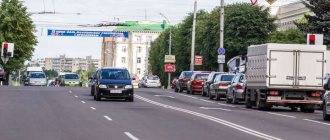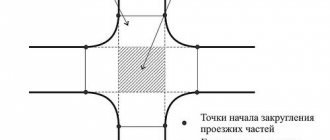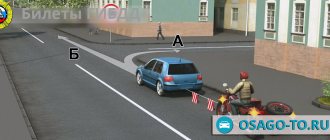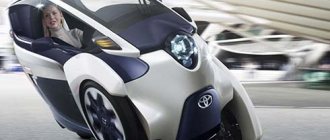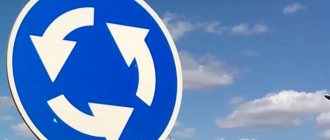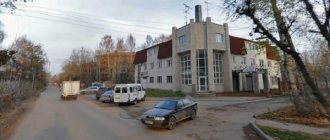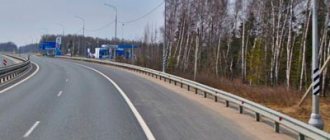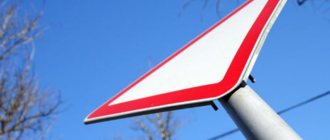First, let's define what is meant by the word “road intersection”.
This is the point or place where roads cross at the same level. The boundaries of the intersection are virtual lines that visually unite the beginnings of the curves of the roadways. The key word in our formulation is “intersection”. At this point, one car must let another car pass, in accordance with section 13 of the Road Traffic Rules (hereinafter referred to as traffic rules).
In order to easily understand the traffic situation and correctly determine who will cross the road intersection first and who should wait a little, you need to accurately navigate which intersection you find yourself at.
Description
In accordance with paragraph 13.3 of the traffic rules, there are 2 types of intersections.
Adjustable
They have a traffic light installed and operating in normal mode, and it is responsible for the correct passage of cars. Depending on his signals or the inspector’s instructions, traffic participants stop or resume their movement.
Important!
If suddenly the traffic light is faulty, turned off, or “yellow” is constantly flashing, we have an unregulated intersection in front of us. Here, drivers and pedestrians are required to adhere to the existing rules governing passage at intersections of this type and take as a basis the road signs of intersections, which will be discussed a little later.
Unregulated
They are determined by the absence of any regulation, and specifically: the traffic light is not working or has switched to “yellow flashing” mode, there is no traffic controller. In this case, everyone needs to be careful and it is advisable to quickly remember the rules for driving through such intersections.
Road intersections can take various forms:
- Quadrilateral in X shape;
- three-sided in the shape of the letter T;
- three-sided Y-shaped with different adjacent ones and at any angle;
- with circular motion.
Video lesson of traffic rules is often the second: types of intersections.
All intersections are divided into two large groups: simple and complex. It all depends on the number of crossings and adjustments. Based on the appearance and direction of roads, cross-shaped, x-shaped, T-shaped, y-shaped and multifaceted intersections are distinguished.
Road intersections can be regulated or unregulated. In this case, the classification is formed depending on the presence of a traffic light and other corrective traffic elements. Outside populated areas, almost all crossings are unregulated. Safe passage in this case depends on the visibility at the intersection and the profile of the roadway.
Road intersections, depending on traffic intensity, can be at the same or different levels. A good example of this would be a highway bridge over a main road.
Crossroads should not be confused with driveways. Outwardly they may be similar, but the passage only serves as a connecting link between highways, types of intersections and parallel streets. It has very limited capacity compared to central intersecting highways. You can learn the features and more about existing types of intersections from video traffic rules lessons.
Explanation
Signs that determine the order of travel at uncontrolled intersections and various intersections (intersection road signs in traffic rules) are classified as priority signs. Basically, they are made in the shape of a triangle with a red rim and at first glance resemble warning signs. Signs indicating priority are placed in advance of intersections; their task is to ensure traffic safety in these areas.
They can be roughly divided into groups.
the main road
Sign 2.1 is “main road”. The driver, seeing this sign, immediately understands that he is a “priority” and can cross the uncontrolled intersection first and not let anyone through. But in any case, he must be extremely careful and slow down, there is a possibility that the other driver may get lost and then a collision cannot be avoided.
Sign 2.1 - “Main Road”
Sign 2.2 “end of the main road” - everything is extremely simple with it. Be careful, the advantage is gone.
This sign does not turn the main road into a secondary one, it is simply now an intersection of equivalent roads.
Sign 2.2 - “End of the main road”
minor road
2.3.1 “Intersection with a secondary road” and 2.3.2 - 2.3.7 “Junction with a secondary road” are similar in meaning and carry information that two roads intersect in front of you: the main one with the secondary one.
It can adjoin the road surface at any angle. These road signs are usually installed outside the city, outside populated areas; they indicate to the motorist that there is an advantage over those on a secondary road.
Sign 2.3.1 - “Intersection with a secondary road”
2.4 “Give way” and 2.5 “Driving without stopping is prohibited” inform the driver that he is on an adjacent secondary road and must wait and let everyone on the main road pass.
When leaving a residential yard or an adjacent area, even if sign 2.4 is missing, give way!
Sign 2.4 - “Give way” and sign 2.5 “Driving without stopping is prohibited”
Equivalent intersection
This is the intersection of roads of equal importance.
Comments
We often notice that the “Main Road” sign is combined with an information plate (clause 8.13), on which the direction of the main road is drawn. This is done so that it is clear how the main road will change its bend at the intersection. If there is no such sign, then it goes straight through the intersection.
If traffic light signals contradict the requirements of priority signs, then in accordance with paragraph 6.15 of the Traffic Regulations, drivers are guided by the traffic light signals.
Sign 2.1 - “Main Road” with sign 8.13 “Direction of the Main Road”
Fines
Failure to comply with the rules for driving through intersections entails the imposition of administrative penalties. A detailed table of fines can be found here.
Based on clause 12.12 part 1, for driving through a red traffic light or a traffic controller's prohibitory sign, the driver is charged a fine of 1,000 rubles.
In the event that the driver of the vehicle does not allow a car to pass, which has the right of way through the intersection, in accordance with clause 12.13, part 2, the fine is 1000 rubles.
Systematic failure to comply with the requirements of traffic rules and repeated violations can lead to more serious consequences: a fine of 5,000 rubles or deprivation of a driver’s license for a period of 4 to 6 months (clause 12.12, part 3).
Uncontrolled intersections
so UNT / Traffic rules / Lesson plans for traffic rules 7th grade
Lesson No. 5. Topic: “Types of intersections”
24.09.2013 40782 0
Lesson objectives:
Introduce students to the types of intersections and the rules for safely crossing the roadway.
Materials for the lesson:
Intersections and their types
The word crossroads is familiar to everyone. But, probably, you did not delve into its meaning, did not think about its meaning.
Crossroads
- a place where roads intersect at the same level.
It would be safer if the roads did not intersect at the same level, but passed one above the other. Then vehicles would not interfere with each other, their paths would not intersect, they would not waste time letting each other pass, and there would be no danger of collisions and run-overs.
Such intersections exist. They are called transport interchanges. But building them is very difficult and expensive. Therefore, there are still few of them, and most roads intersect at the same level.
There are different intersections. It depends on how the roads intersect with each other.
T-shaped three-way intersection.
Transport comes from three directions.
X-shaped four-way intersection. Transport comes from four directions.
Y-shaped three-way intersection. Transport comes from three directions.
| Multi-way intersection (intersection of more than two roads). Transport comes from many directions. | The square is an intersection of complex shape (the intersection of more than four roads). |
An intersection is not only a place where vehicles and pedestrians intersect; here vehicles turn left and right, and turn in the opposite direction. Their paths not only intersect with each other, but also intersect the paths of pedestrians.
To make traffic at an intersection safe, traffic lights and road signs are installed, road marking lines are applied to the roadway, and vehicles are equipped with special warning signals.
A pedestrian at an intersection, before starting to cross the street, must understand many things, including it is very important for him to know whether cars are going straight or turning. A pedestrian can learn about this from the drivers themselves. How?
Drivers use warning signals installed on vehicles to inform each other and pedestrians of their actions. These signals include direction indicator lights. They are commonly called "flashers" because they flash when turned on. If the driver turns on the left flasher, he warns about a left turn; he turns on the right flasher, he warns about a right turn. Using these signals, other drivers, as well as pedestrians, learn about the driver’s intention to go in one direction or another.
To make turn signals - “flashing lights” - more visible, three of them are installed on each side of the vehicle. In front there is a white light, on the side - yellow, in the back - yellow or red.
If vehicles do not have turn signal lights (for example, on bicycles) or are found to be faulty, turn signals must be given by hand.
Sound signals are also installed on vehicles. Sound signals are prohibited in populated areas. They can be used to prevent traffic accidents. This is also permitted on country roads. But if the road passes next to a hospital, sanatorium, rest home, kindergarten, etc., then sounding a sound signal may be prohibited on this section of the road, and then a road sign “Sound Signal Prohibited” is installed there.
If at an intersection there is neither a traffic light nor a traffic controller who would determine the order of movement of pedestrians and vehicles, then such an intersection is called uncontrolled. The pedestrian crossing located at such an intersection is also unregulated.
Let us consider in detail how to cross the road at a pedestrian crossing located at an uncontrolled intersection.
Let's start with the transition notation. It can be marked with “Pedestrian crossing” road signs, and sometimes, in addition to the signs, also with “zebra crossing” road markings.
If the pedestrian crossing at the intersection is not marked, then you need to cross the road along the line of continuation of the sidewalks. These lines are conditional, i.e. not indicated in any way, they should be carried out mentally.
The rules for crossing the road at an unregulated pedestrian crossing do not depend on how it is marked or whether it is marked at all.
The transition rules are always the same.
The transition symbols only serve to define its width.
If there is a zebra marking on a crossing, then it determines its width: the width of the zebra itself is the width of the crossing.
If the transition is indicated only by signs, then the width of the transition is equal to the distance between the signs.
If the pedestrian crossing at the intersection does not have any markings (pedestrians are allowed to cross the road along the sidewalk line), then the width of the crossing is equal to the distance between the conventional sidewalk lines.
Sometimes at an intersection there are barriers along the edge of the sidewalk that prevent crossing. Of course, crossing the road in such places is prohibited. It may be prohibited even in the absence of fences, if there is a sign “Pedestrian traffic is prohibited.” This is a round prohibition sign with a red border. A walking pedestrian is depicted on a white background, crossed out with a red line.
Consider an uncontrolled pedestrian crossing located at a regular four-way intersection.
You have come to an intersection. We determined by known signs where the pedestrian crossing was located. We stopped in front of the curb and analyzed what the intersection was like: in what directions are the vehicles traveling, where could the danger come from?
At such an intersection, vehicle traffic goes in four directions. Which vehicles are dangerous for you?
In the first part of the path along the transition, danger will only appear on the left. In the second part of the path there will be danger - only on the right.
Vehicles coming from the right can appear from three directions: directly to the right, on a right turn, and on a left turn. You already know how drivers use warning signals to report their actions.
In the second part of the path, only cars driving straight can create a danger on the right.
It can be seen that in one case the first part of the path across the road is easier, and the second is more difficult, and in the other, vice versa. However, in any situation, crossing the road at an uncontrolled intersection requires attention and responsibility.
When making a right or left turn at an intersection, the driver is obliged to give way to pedestrians crossing the street into which the car is turning. However, make sure that the driver gives way to you. If you are not sure about this, let the car pass yourself.
Sometimes you can see how at intersections some pedestrians, wanting to reduce the distance, follow the path shown in the figure.
This is a very risky path: for most of it, the pedestrian turns his back to the sides of the possible appearance of transport.
Those pedestrians who, at intersections formed by narrow “quiet” streets, do not cross the road as expected, but diagonally, right through the intersection, also behave unacceptable. The appearance of a car on a “quiet” street is always unexpected, and a pedestrian caught at an intersection behaves unpredictably: it is impossible for the driver to guess where he will run to escape the car. Most often, such cases end in disaster.
Rules for crossing the road at a pedestrian crossing at an unregulated intersection
1. Stop at the pedestrian crossing on the edge of the sidewalk, without stepping on the curb.
2. Look left and right. Determine in which directions vehicles are traveling at the intersection: are there any cars making turns in the direction of the pedestrian crossing.
3. Give way to all nearby vehicles.
4. Start crossing only at a safe distance from vehicles. Be aware of vehicles making turns!
5. Cross the roadway at a brisk pace, but not running.
6. While crossing, do not stop watching for vehicles on the left, and after the middle of the roadway - on the right.
7. Walk along the crossing at right angles to the roadway, and not diagonally, sticking to the right side.
Questions for consolidation:
1. In what places do pedestrians have the right to cross the roadway?
2. What types of intersections and ways of marking pedestrian crossings do you know?
3. What are the rules for crossing uncontrolled intersections?
4. What speed should a pedestrian choose when crossing the road?
